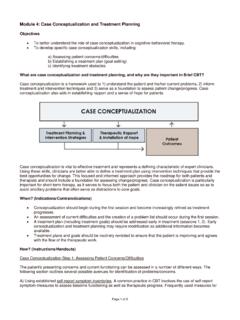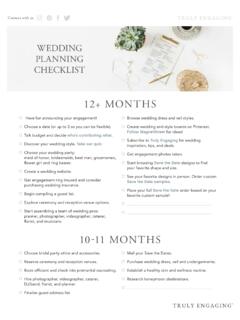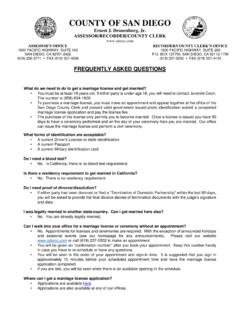Transcription of Module 9: Identifying Maladaptive Thoughts and Beliefs
1 Page 1 of 10 Module 9: Identifying Maladaptive Thoughts and Beliefs Objectives: To understand the role of Maladaptive Thoughts and Beliefs in Brief CBT To learn methods for educating the patient about Maladaptive Thoughts and Beliefs What are Maladaptive Thoughts , and Beliefs and why they are important in Brief CBT? The cognitive-behavioral model (as depicted below) suggests that three layers of cognitive dysfunction exist in individuals struggling with social and/or psychological problems: Automatic Thoughts , intermediate Beliefs , and core Beliefs . An automatic thought is a brief stream of thought about ourselves and others.
2 Automatic Thoughts largely apply to specific situations and/or events and occur quickly throughout the day as we appraise ourselves, our environment, and our future. We are often unaware of these Thoughts , but are very familiar with the emotions that they create within us. Maladaptive automatic Thoughts are distorted reflections of a situation, which are often accepted as true. Automatic Thoughts are the real-time manifestations of dysfunctional Beliefs about oneself, the world, and the future that are triggered by situations or exaggerated by psychiatric states, such as anxiety or depression.
3 Intermediate Beliefs are attitudes or rules that a person follows in his/her life that typically apply across situations (not situation specific as with automatic Thoughts ). Intermediate Beliefs can often be stated as conditional rules: It x , then y. For example, If I am thin, then I will be loved by others. Individuals create these assumptions by categorizing the information they receive from the world around them. These rules guide Thoughts and subsequently influence behaviors. Dysfunctional core Beliefs drive dysfunctional rules and automatic Thoughts .
4 For example, the belief , I am unlovable, may be driving the conditional rule, If I am thin, then I will be loved by others, which may drive obsessive thinking about one s appearance, excessive exercise, or disordered eating habits. Core Beliefs are often formed in childhood and solidified over time as a result of one s perceptions of experiences. Because individuals with Page 2 of 10 psychological disorders tend to store information consistent with negative Beliefs but ignore evidence that contradicts them, core Beliefs tend to be rigid and pervasive. Although automatic Thoughts are often tied to a specific situational trigger, intermediate and core Beliefs are more global and cut across domains.
5 Beck suggests that individuals tend to have core Beliefs that involve either interpersonal ( I m unlovable ) or achievement issues ( I m incompetent ). When? (Indications/Contraindications) Identifying Maladaptive automatic Thoughts is the first step in the cognitive component of therapy. The focus of intervention in Brief CBT is the dysfunctional automatic thought . Patients must master Identifying and challenging Thoughts to be able to grasp the concept and techniques of challenging Beliefs . Because of the interrelated nature of Thoughts and Beliefs , an intervention targeting automatic Thoughts may also change underlying Beliefs (depicted below).
6 Therefore, Brief CBT can result in belief modification, even if the target of treatment was automatic Thoughts . Because patients progress through treatment at different rates, you may be able to identify and challenge some Beliefs late in brief therapy (sessions 5-8) for some patients. For other patients, work will be limited to automatic Thoughts . Although you may not discuss Beliefs directly with the patient, as part of the case conceptualization, he/she should constantly be forming hypotheses about what Beliefs may be driving the Thoughts (see Module 4: Case Conceptualization and Treatment planning ).
7 Because skill building to alleviate symptoms and prevent relapse is a central focus of CBT, mastery of skills is paramount. Focus on building a skill set with the patient that he or she can generalize to different situations, Thoughts , or Beliefs . It is less important to identify and modify deep-seated childhood Beliefs . For most patients in Brief CBT, this will not be necessary for symptom reduction. However, some patients may benefit from this work. Page 3 of 10 In Identifying Thoughts and Beliefs , ask yourself several questions. Is the thought / belief secondary to another thought / belief ?
8 How much does the patient believe it? Does it affect the patient s life negatively? Is the patient prepared to work on it now, or should he/she tackle the belief at a later date? After an automatic thought or belief is identified, it is challenged using the skills in Module 9. How? (Instructions/Handouts) Explaining Automatic Thoughts to your Patient It is important for the patient to understand the rationale for Identifying automatic Thoughts before acquiring the skill of addressing his/her own Thoughts . Using the situation thought feeling triangle introduced in Module 5 (Orienting the Patient to Brief CBT) can be helpful in explaining automatic Thoughts .
9 Completing the triangle with the patient s recent or current automatic Thoughts can facilitate his/her understanding. Using the patient's example, describe the association between Thoughts and feelings to build awareness of the connection. This is a good time for the patient to write down the thought and begin using the cognitive-behavioral model. Therapist: So, Pamela, how have you been feeling this week? Pamela: Just really usual. It seems like I m always feeling that way. Therapist: Did anything in particular trigger this sad feeling this weekend?
10 Pamela: Yes, I had to go to my cousin s wedding , and it was really difficult because I started thinking about how I will never get married. Therapist: Pamela, that s what we call an automatic thought . It s something that just pops into our heads over and over again without our really thinking about it or examining the truth of the thought . It affects the way we feel and act in a negative way. Maybe we should look at some of your automatic Thoughts a little closer. Therapist: So, let s write down this automatic thought that you are having. I will never get married.








